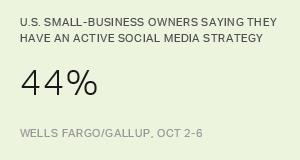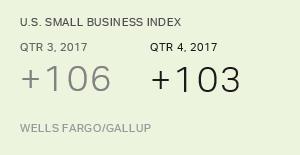Most large U.S. retail companies are focused on maximizing the potential of social media as a way of communicating with customers and are embracing the internet as a way of allowing customers to view and purchase products and services. The nation's small-business owners may be lagging behind on this front, however -- missing opportunities to take advantage of new ways of expanding their businesses and beating their competition.
These conclusions arise from an analysis of small-business owners' responses to a series of questions included in the latest Wells Fargo/Gallup Small Business Index survey -- questions asking about social media and new "e-commerce" technology.
The survey found that less than half (44%) of owners say their business has an "active social media strategy."
Owners' definitions of an active social media strategy may vary widely, of course. Responses to other questions in the survey show that in fact a bit more than the 44% who report having a social media strategy are actually doing things that relate to social media:
- Some 53% of owners say their business has an active media presence on Facebook. The difference between the number who perceive themselves as having a social media strategy and the larger number who are on Facebook suggests some owners use the latter, but not in a systematic way. About a third of owners say they have a presence on LinkedIn.
- Over half of small-business owners say social media is very or somewhat important in helping them acquire new customers (54%), helping them market to new and existing customers (53%) and allowing them to advertise their business (52%). Here again, these results suggest that at least some owners are making use of social media to help their businesses, even without having a fully developed strategy for what they are doing.
Additionally, 51% say they are very or somewhat likely to increase their online presence through online marketing and social media sites in the year ahead.
As is often the case, interpreting these results is a glass-half-empty versus a glass-half-full choice. Just over half of small-business owners are using social media in some way, even if some owners don't have a carefully laid-out plan. This means almost half aren't engaging in the specific types of activities we asked them about.
There's also evidence from the Wells Fargo/Gallup Small Business Index survey that less than a majority of small businesses are embracing e-commerce on the web. Two in 10 report they have expanded the "e-commerce presence" of their business over the past two years, and less than a quarter have invested in apps or mobile optimization capabilities for their website. More specifically, about a quarter of owners interviewed said their business has a way for customers to order products or services directly using their smartphone or computer, or a way for customers to pay for their products and services directly. A similarly small percentage of small businesses allow customers to schedule appointments or services directly using the internet.
There is also no apparent groundswell of interest in doing more in the e-commerce sphere in the future. Most broadly, only 11% of small-business owners say they intend to increase their business' e-commerce presence within the next year, a little lower than the percentage who said this in the first quarter of 2016. About one in four owners say it's very likely they will increase online marketing and use of social media. But, importantly, about the same percentage indicated they would be doing these things in the first quarter of 2016. And the 13% who say they will increase efforts to deal with customers via online applications or mobile apps is down from 21% at the beginning of last year.
Digital payment options? Just 9% say it's very likely they will add or update these over the next year, unchanged from early 2016.
Not all small businesses are the same, of course, and many really small businesses -- such as a one-person accounting or law firm, or other "mom and pop" operations -- may have sufficient business without having to embrace technologies that allow customers to interact with them via the web. And, some small businesses may be totally focused on in-person retail where web contact wouldn't be a reasonable option.
Still, the data show no signs of increased e-commerce activity compared with almost two years ago when we first asked these questions. Either small-business owners are finding that the tidal wave of movement toward doing business on the web has little applicability to their situation, or they have other reasons for not investing in the advantages it would bring to them.
Overall, the results certainly seem to suggest the possibility for untapped potential if small businesses can figure out how to get more involved in social media and in e-commerce. And, of course, there is also a major opportunity awaiting companies that can provide these services for the nation's small businesses.




